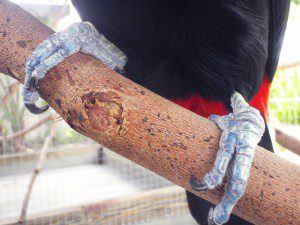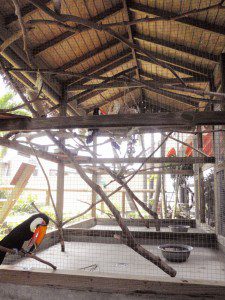When we were setting up the toucan enclosures for their arrival, I was most excited about arranging their perches – I wanted it to be like a jungle-gym for toucans with plenty of fun places to hop. Toucans love to bounce around constantly and need full access to all areas of their cage to truly enjoy their space. But before we could assemble the perfect web of perches for The Trio, we needed to determine what materials were safe to use for toucan perches.
The nice thing about toucans vs. parrots (please note: I love them all, this is not a competition people! 😉 ) is that they are not chewers. They will picks at things, but they don’t have much leverage in that long beak of theirs – meaning, they do not eat their perches. But even so, I wanted to be certain the wood we chose was non-toxic so in the event that they happened to munch a piece of bark (which they do, occasionally), it’s not a life or death situation.
There are quite a few sites that provide detailed lists of toxic/non-toxic perch options – my favorite is this one on safe woods.
Luckily for us, the three main trees we have on-island are sea grape, almond, and palm, all of which are non-toxic. Seriously – I felt like I won the lottery. Living on a remote island where EVERYTHING has to be shipped in, I was already trying to calculate the shipping for large branches to be used for toucan perches – you can only imagine. Instead (for once), options abound on our little rock! We ended up choosing mostly almond tree branches and some palm to start with. The almond tree has beautiful branches of varying sizes – plus the tree is enormous so I didn’t feel guilty taking some from “the giving tree”. I was confident that the turtle doves that roost there would still have plenty o’ options. For the palm perches, we had already had to cut down a few palm trees in the space we built the cages, so it was great to be able to use the trunks so they did not have to die in vain.
As far as longevity is concerned, the almond branches have held up well. We re-arrange them from time to time for enrichment, but they have staying power. The palm are another story. If using palm tree trunks for perches, just count on them only lasting a few months – due to their moist stalk they dry up and shrivel pretty quickly. But they are fun for the birds while they last as they enjoy picking and shredding their stringy fibers.
A couple of tips on choosing natural perches for your beloved birdies….
- choose a variety of widths to give their feet different size perches to grab – no one likes a crampy claw
- ensure the woods you use have not been sprayed with pesticides – if so, just say NO
- watch out for bugs – check for any rotting or nests inside for signs of pests





